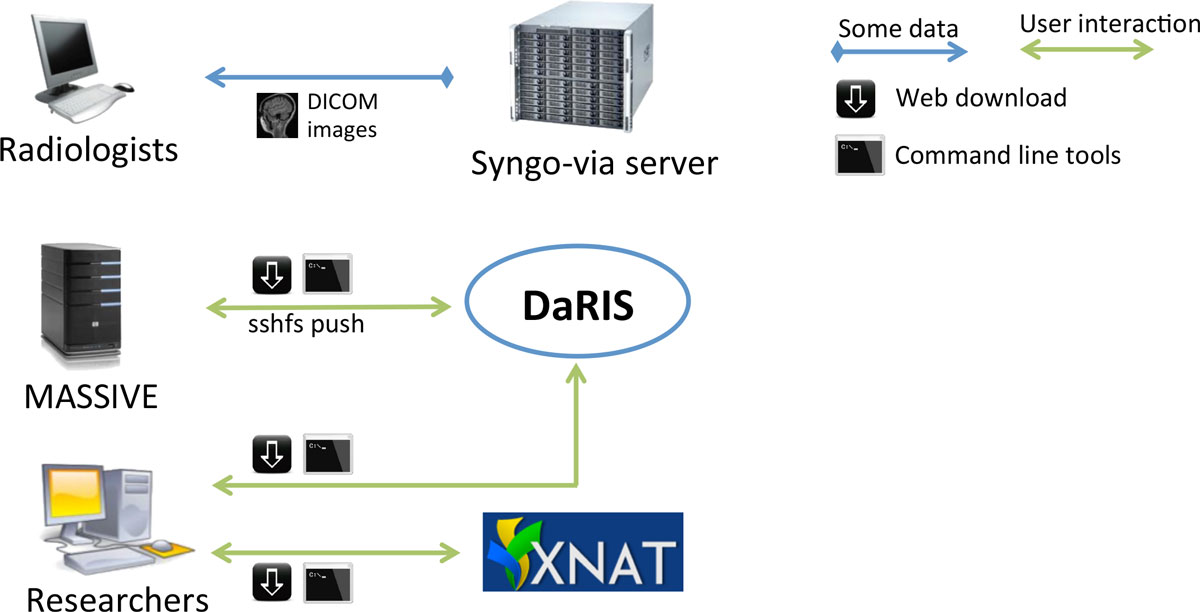Difference between revisions of "Template:Article of the week"
Shawndouglas (talk | contribs) m (Corrected title) |
Shawndouglas (talk | contribs) (Updated article of the week text.) |
||
| Line 1: | Line 1: | ||
<div style="float: left; margin: 0.5em 0.9em 0.4em 0em;">[[File: | <div style="float: left; margin: 0.5em 0.9em 0.4em 0em;">[[File:Fig3 Nguyen HealthInfoSciSys2015 3-Suppl1.jpg|240px]]</div> | ||
"[[Journal:Design, implementation and operation of a multimodality research imaging informatics repository|Design, implementation and operation of a multimodality research imaging informatics repository]]" | |||
Biomedical imaging research increasingly involves acquiring, managing and processing large amounts of distributed imaging data. Integrated systems that combine data, meta-data and workflows are crucial for realising the opportunities presented by advances in imaging facilities. This paper describes the design, implementation and operation of a multi-modality research imaging data management system that manages imaging data obtained from biomedical imaging scanners operated at Monash Biomedical Imaging (MBI), Monash University in Melbourne, Australia. In addition to [[DICOM|Digital Imaging and Communications in Medicine]] (DICOM) images, raw data and non-DICOM biomedical data can be archived and distributed by the system. Imaging data are annotated with meta-data according to a study-centric data model and, therefore, scientific users can find, download and process data easily. The research imaging data management system ensures long-term usability, integrity inter-operability and integration of large imaging data. Research users can securely browse and download stored images and data, and upload processed data via subject-oriented [[informatics]] frameworks including the Distributed and Reflective Informatics System (DaRIS), and the Extensible Neuroimaging Archive Toolkit (XNAT). ('''[[Journal:Design, implementation and operation of a multimodality research imaging informatics repository|Full article...]]''')<br /> | |||
<br /> | <br /> | ||
''Recently featured'': | ''Recently featured'': | ||
* [[Forensic science]] | |||
* [[Journal:Djeen (Database for Joomla!’s Extensible Engine): A research information management system for flexible multi-technology project administration|Djeen (Database for Joomla!’s Extensible Engine): A research information management system for flexible multi-technology project administration]] | * [[Journal:Djeen (Database for Joomla!’s Extensible Engine): A research information management system for flexible multi-technology project administration|Djeen (Database for Joomla!’s Extensible Engine): A research information management system for flexible multi-technology project administration]] | ||
* [[Journal:SeqWare Query Engine: Storing and searching sequence data in the cloud|SeqWare Query Engine: Storing and searching sequence data in the cloud]] | * [[Journal:SeqWare Query Engine: Storing and searching sequence data in the cloud|SeqWare Query Engine: Storing and searching sequence data in the cloud]] | ||
Revision as of 15:55, 14 March 2016
"Design, implementation and operation of a multimodality research imaging informatics repository"
Biomedical imaging research increasingly involves acquiring, managing and processing large amounts of distributed imaging data. Integrated systems that combine data, meta-data and workflows are crucial for realising the opportunities presented by advances in imaging facilities. This paper describes the design, implementation and operation of a multi-modality research imaging data management system that manages imaging data obtained from biomedical imaging scanners operated at Monash Biomedical Imaging (MBI), Monash University in Melbourne, Australia. In addition to Digital Imaging and Communications in Medicine (DICOM) images, raw data and non-DICOM biomedical data can be archived and distributed by the system. Imaging data are annotated with meta-data according to a study-centric data model and, therefore, scientific users can find, download and process data easily. The research imaging data management system ensures long-term usability, integrity inter-operability and integration of large imaging data. Research users can securely browse and download stored images and data, and upload processed data via subject-oriented informatics frameworks including the Distributed and Reflective Informatics System (DaRIS), and the Extensible Neuroimaging Archive Toolkit (XNAT). (Full article...)
Recently featured:










